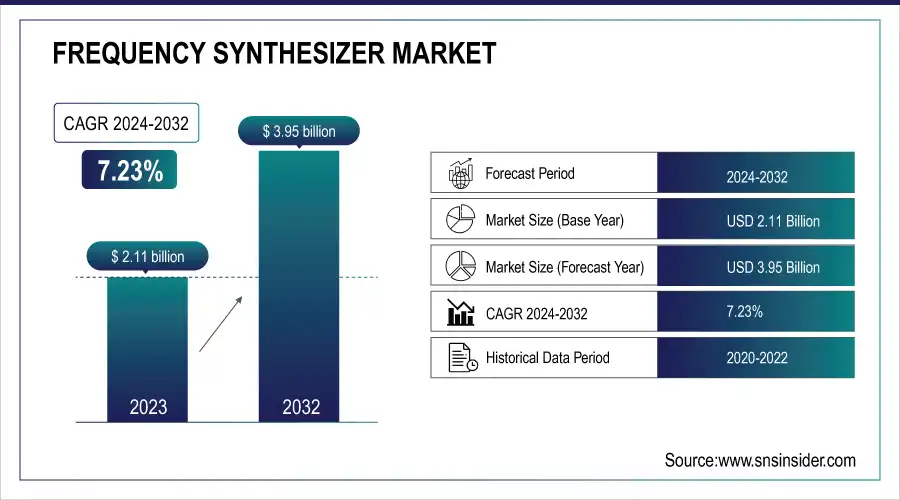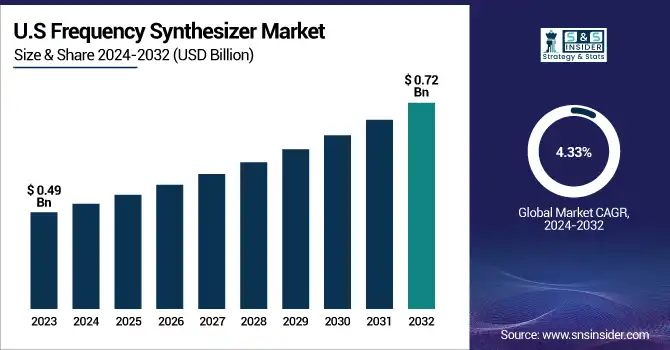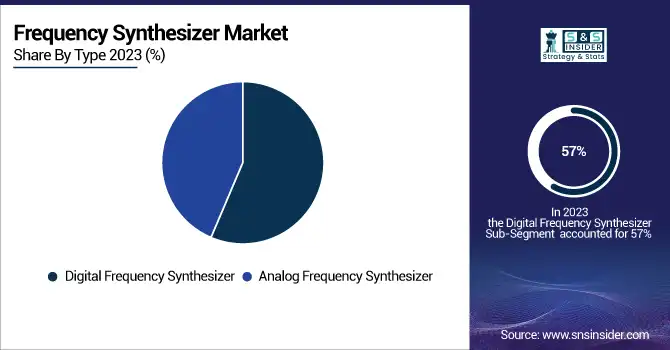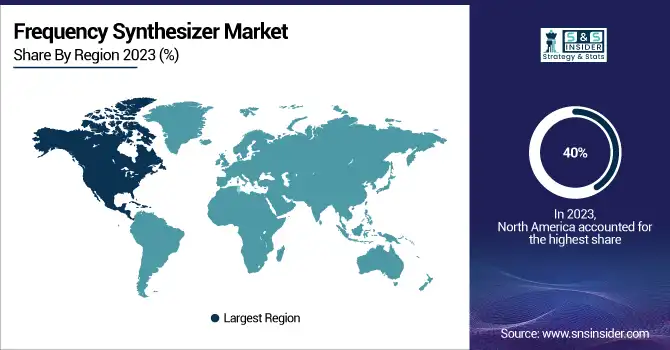Frequency Synthesizer Market Size & Growth:
The Frequency Synthesizer Market was valued at USD 2.11 Billion in 2023 and is projected to reach USD 3.95 Billion by 2032, growing at a CAGR of 7.23% from 2024 to 2032.
The Frequency Synthesizer Market is experiencing considerable expansion driven by several key factors. The demand for precise and stable signal generation across industries such as telecommunications, defense, and consumer electronics is accelerating market growth. Moreover, the rise of advanced communication technologies like 5G and the Internet of Things (IoT) is intensifying the need for high-performance frequency synthesizers to support faster and more reliable data transmission.

To Get more information on Frequency Synthesizer Market - Request Free Sample Report
In the US, the market was valued at USD 0.49 billion in 2023 and is expected to grow to USD 0.72 billion by 2032, at a CAGR of 4.33%. Additionally, trends such as miniaturization, along with the increasing demand for energy-efficient and eco-friendly solutions, are encouraging the development of more compact and sustainable devices. Innovations in manufacturing techniques, including MEMS-based frequency synthesizers and software-defined synthesis, are improving product flexibility, scalability, and cost-effectiveness, further driving market advancements.

Frequency Synthesizer Market Dynamics:
Drivers:
-
The Growing Need for High-Precision Frequency Synthesis Across Telecommunications, Aerospace, Defense, and Consumer Electronics.
The increasing need for precision in industries such as telecommunications, aerospace, defense, and consumer electronics is a major driver of the frequency synthesizer market. In telecommunications, precise frequency generation is essential for stable and efficient communication networks, especially with the ongoing rollout of 5G. Aerospace and defense applications require highly accurate and stable frequency signals for radar systems, navigation, and secure communications, where even slight deviations can impact performance. Consumer electronics, particularly in devices like smartphones and IoT devices, demand high-quality frequency synthesizers for seamless functionality. As these industries push for faster, more reliable, and efficient systems, the need for advanced frequency synthesizers capable of generating precise and stable signals becomes increasingly critical, propelling the market’s growth. This demand is further amplified by innovations in technology, driving continuous advancements in frequency synthesis.
Restraints:
-
The Complexity of Integrating and Calibrating Frequency Synthesizers Limits Their Widespread Adoption.
The integration and calibration of frequency synthesizers can be a complex and time-intensive process, limiting their widespread use. These devices require precise calibration to ensure accurate frequency generation, particularly in high-precision applications like telecommunications, aerospace, and defense. Even slight inaccuracies in frequency output can compromise system performance, especially in mission-critical operations such as secure communications or radar systems. Calibration adjustments are necessary to align the synthesizer’s internal components, ensuring optimal functionality. Additionally, integrating frequency synthesizers with other electronic systems requires careful compatibility checks across hardware, software, and communication protocols. This process requires technical skills, resulting in an typically expensive and prolonged integration. With industries screaming for faster and speedier technologies, these nuances of calibration and integration can prolong the adoption of frequency synthesizers and become an impediment in scaling and also affects the attractiveness of the product in cost-sensitive areas.
Opportunities:
-
The Role of Frequency Synthesizers in 5G and Future Communication Networks
The deployment of 5G and the evolution of next-generation communication technologies offer significant growth prospects for frequency synthesizers. These technologies require high-precision and stable frequency generation to support faster data transmission, ultra-low latency, and robust network performance. High-bandwidth communications for 5G networks, especially those that will use millimeter-wave frequencies, will require frequency synthesizers for almost seamless connectivity. With the growing prevalence of IoT devices and smart cities, the frequency synthesizer will play a vital role in maintaining the robust performance of a variety of applications, from autonomous driving to industrial automation. Additionally, the spread of Wi-Fi 6 and satellite communication networks will drive the demand for versatile frequency synthesizers, providing significant growth potential to manufacturers to innovate and address the needs of next-gen communication infrastructure.
Challenges:
-
Miniaturization and Power Efficiency Challenges in Frequency Synthesizers
With the growing demand for smaller, portable, and energy-efficient devices, frequency synthesizers face significant challenges in miniaturization and power optimization. As industries like telecommunications, consumer electronics, and IoT push for more compact and power-efficient solutions, frequency synthesizers must be designed to fit into these smaller form factors while maintaining their performance standards. This requires engineers to focus on reducing the size of components without compromising signal stability, frequency accuracy, or reliability. Additionally, as devices become more power-conscious, synthesizers must be optimized for low power consumption to extend battery life and meet energy-efficiency standards. Achieving the perfect balance between miniaturization, power efficiency, and performance becomes crucial for the successful integration of frequency synthesizers into modern electronic systems.
Frequency Synthesizer Market Segmentation Outlook:
By Type
The Digital Frequency Synthesizer segment leads the market, accounting for approximately 57% of the revenue share in 2023. It is expected to be the fastest-growing segment from 2024 to 2032. This growth is driven by the increasing demand for high-precision, stable frequency generation across industries like telecommunications, aerospace, defense, and consumer electronics. Digital synthesizers offer significant advantages over analog alternatives, such as superior performance, higher frequency stability, and faster switching speeds. They are particularly crucial in supporting the evolving requirements of 5G networks, IoT devices, and advanced communication systems. With their ability to handle high-frequency ranges and their scalability for various applications, digital frequency synthesizers are becoming the go-to solution for modern high-performance technologies, driving their rapid growth in the coming years.

By Component
The Oscillators segment holds a dominant market share of around 42%in 2023 and is expected to experience the fastest growth from 2024 to 2032. This growth is driven by the increasing demand for high-precision oscillators in various applications, including telecommunications, aerospace, and consumer electronics. Oscillators play a critical role in generating stable and accurate signals for communication systems, radar systems, and high-performance computing devices. As the need for faster, more reliable data transmission and signal processing grows, oscillators are becoming essential components in modern technologies, including 5G networks and IoT devices. Their ability to offer improved performance, frequency stability, and miniaturization drives their rapid adoption and expansion in the market.
By Frequency Range
The High Frequency segment holds a dominant market share of around 46% in 2023 and is expected to be the fastest-growing segment during the forecast period from 2024 to 2032. The demand for high-frequency signals in applications such as telecommunications, aerospace, defense, and high-speed data transfer systems is driving the growth of this segment. Such high-frequency synthesizers play an important role in enabling emerging technologies like 5G, the Internet of Things (IoT), and radar systems, which need stable and accurate frequency generation for high-speed and reliable communications. This demand for high-frequency synthesizers is driven by the increasing demand for high-speed data transmission and low-latency communication on the next-generation communication network. With a growing requirement for such high-performance and wideband solutions, the high-frequency segment is projected to continue its growth and dominance in the market.
By End Use
The Commercial segment dominates the frequency synthesizer market, accounting for approximately 51% of the revenue share in 2023. This sector's significant share is driven by the widespread use of frequency synthesizers in commercial applications, including telecommunications, broadcasting, and consumer electronics. As the demand for high-speed, reliable communication networks and devices grows, especially with the expansion of 5G technologies, the need for precise and stable frequency generation is more critical than ever. Commercial applications require synthesizers that offer high performance, stability, and scalability to support advanced systems. The continued growth of the telecommunications and consumer electronics industries is expected to further strengthen the dominance of the commercial segment throughout the forecast period from 2024 to 2032.
The Industrial segment is expected to experience significant growth in the frequency synthesizer market over the forecast period from 2024 to 2032. Increasing adoption of advanced technologies for different industrial applications such as automation, robotics, and control systems among others is one of the major factors driving the growth of the market. Given that these systems rely on the precision and stability of their signals, frequency synthesizers play a critical role in ensuring that these systems function accurately and perform well. As the adoption of advanced technologies such as Industry 4.0, IoT, and AI accelerate in multiple sectors, the market for advanced frequency synthesizers will increase. They are vital for the further development of manufacturing and production processes and are widely used because they facilitate smooth communication and accurate timing of industrial machinery and equipment. This phenomenon is likely to drive the industrial segment towards vigorous growth in the near future.
Frequency Synthesizer Market Regional Analysis:
The North America segment is to dominate the frequency synthesizer market, accounting for around 40% of the revenue share by 2032. This dominance is driven by the region’s strong technological infrastructure, high demand for advanced communication systems, and leadership in sectors such as telecommunications, aerospace, and defense. North America continues to be at the forefront of 5G deployment, IoT development, and research in cutting-edge technologies, all of which rely on high-precision frequency synthesizers. The presence of major players, significant investments in R&D, and the growing need for reliable, high-performance signal generation in various applications further solidify North America's leadership in the market. These factors are expected to sustain the region's dominant position through 2032.

Get Customized Report as per Your Business Requirement - Enquiry Now
The Asia-Pacific region is expected to witness the fastest growth in the frequency synthesizer market from 2024 to 2032. This rapid growth is fueled by the region's expanding telecommunications infrastructure, increasing adoption of 5G technologies, and the rise of smart manufacturing powered by Industry 4.0 and IoT. Countries like China, Japan, and India are heavily investing in advanced technologies across industries, including automotive, consumer electronics, and telecommunications, all of which rely on high-precision frequency synthesizers. Additionally, Asia-Pacific’s growing market for mobile devices and the demand for reliable communication systems contribute to the region's fast-paced market expansion. As the adoption of cutting-edge technologies continues to rise, Asia-Pacific is poised to be a key driver of growth in the frequency synthesizer market through 2032.
Major Players in Frequency Synthesizer Market along with their Products:
-
Analog Devices, Inc. (USA) –AD9576 Clock Generator
-
EM Research, Inc. (USA) –EM5K Series Synthesizers
-
L3 Narda-Miteq (USA) –Synthesizer Modules
-
Mercury United Electronics Inc. (USA) –Frequency Generators
-
Micro Lambda Wireless, Inc. (USA) –Microwave Synthesizers
-
Programmed Test Sources Inc. (USA) –Test Signal Generators
-
Qorvo Inc. (USA) –IQSynth Frequency Synthesizers
-
Signalcore, Inc. (USA) –Signal Generators
-
Sivers IMA AB (Sweden) –High-Frequency Synthesizers
-
Texas Instruments Incorporated (USA) –Clock Synthesizers
-
Teledyne Microwave Solutions (USA) –Microwave Synthesizers
List of suppliers that provide raw materials and components for the frequency synthesizer market:
-
3M
-
NXP Semiconductors
-
Infineon Technologies
-
STMicroelectronics
-
Mitsubishi Electric
-
Keysight Technologies
-
Qualcomm
-
Broadcom Inc.
-
Murata Manufacturing
-
Rohm Semiconductor
-
Avnet
Recent Development:
-
November 4, 2024, Bard Frequency Vault, a new 34HP Eurorack filterbank, features triode Sallen-Key type filters with vacuum tubes, offering unique sound shaping capabilities with bandpass filters and independent resonance controls. The analog filterbank incorporates seven vacuum tubes and 15 vactrols, adding depth and character to the sound.
-
18 November 2024, The DFG has extended funding for the "MINTS" project to advance THz frequency synthesizers, aiming for high precision and reduced phase noise. This research, led by Paderborn University and Fraunhofer HHI, targets applications in communication, security, and materials research.
| Report Attributes | Details |
|---|---|
| Market Size in 2023 | USD 2.11 Billion |
| Market Size by 2032 | USD 3.95 Billion |
| CAGR | CAGR of 7.23% From 2024 to 2032 |
| Base Year | 2023 |
| Forecast Period | 2024-2032 |
| Historical Data | 2020-2022 |
| Report Scope & Coverage | Market Size, Segments Analysis, Competitive Landscape, Regional Analysis, DROC & SWOT Analysis, Forecast Outlook |
| Key Segments | • By Type(Analog Frequency Synthesizer , Digital Frequency Synthesizer) • By Component(Phase Detectors, Loop Filters, Oscillators, Mixers , Others), By(Frequency Range , Low Frequency, High Frequency , Ultra-high Frequency) • By End Use (Commercial, Residential, Industrial) |
| Regional Analysis/Coverage | North America (US, Canada, Mexico), Europe (Eastern Europe [Poland, Romania, Hungary, Turkey, Rest of Eastern Europe] Western Europe] Germany, France, UK, Italy, Spain, Netherlands, Switzerland, Austria, Rest of Western Europe]), Asia-Pacific (China, India, Japan, South Korea, Vietnam, Singapore, Australia, Rest of Asia-Pacific), Middle East & Africa (Middle East [UAE, Egypt, Saudi Arabia, Qatar, Rest of Middle East], Africa [Nigeria, South Africa, Rest of Africa], Latin America (Brazil, Argentina, Colombia, Rest of Latin America) |
| Company Profiles | Analog Devices, Inc. (USA), EM Research, Inc. (USA), L3 Narda-Miteq (USA), Mercury United Electronics Inc. (USA), Micro Lambda Wireless, Inc. (USA), Programmed Test Sources Inc. (USA), Qorvo Inc. (USA), Signalcore, Inc. (USA), Sivers IMA AB (Sweden), Texas Instruments Incorporated (USA), Teledyne Microwave Solutions (USA). |

